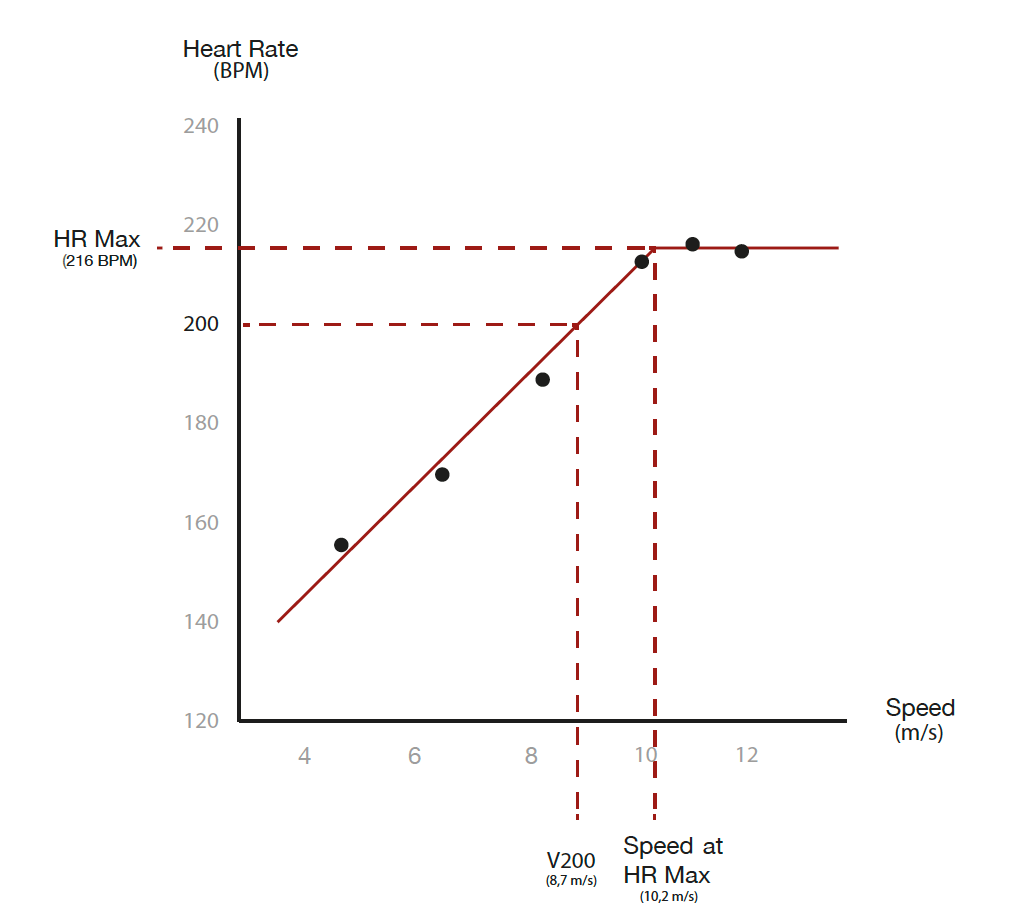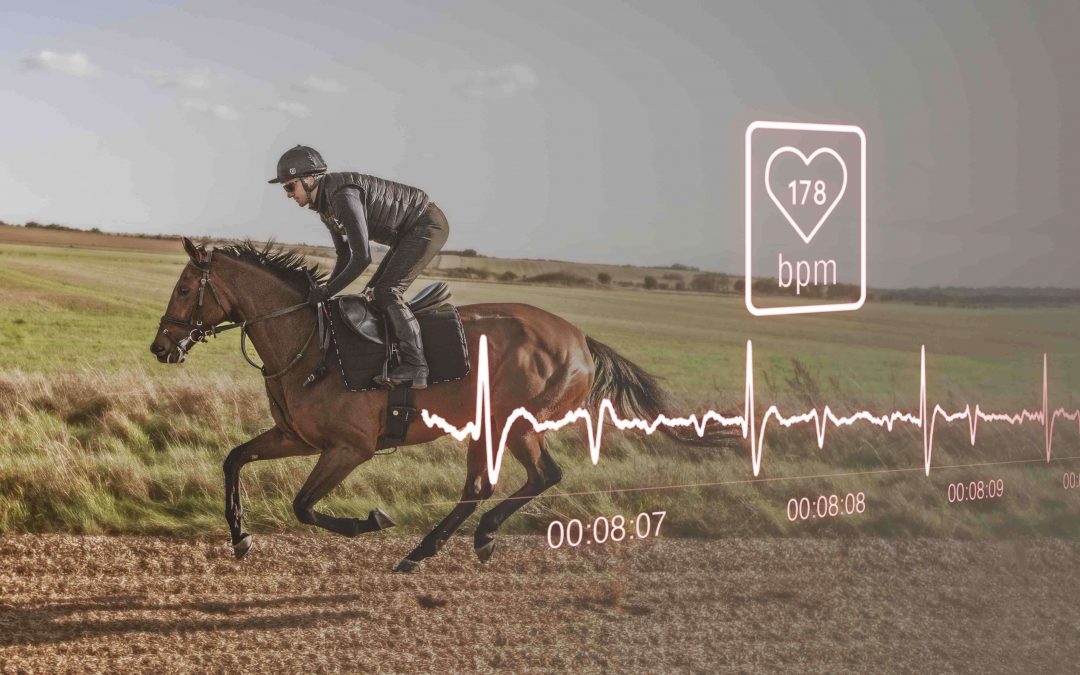The racehorse’s heart rate provides important information about its cardiovascular health and its capacity to cope with training.
Heart rate allows quantification of the intensity of the exercise, the level of performance, the quality of recovery…
A few physiological concepts
The cardiovascular system is composed of the heart and blood vessels. It allows efficient blood circulation and ensures the transport of a large volume of oxygen, especially to the muscles. The volume of blood that the heart ejects at each beat during cardiac contraction (stroke volume) is more than one liter in the racehorse. The weight of the heart represents about 1% of the mass of a horse during training will tend to increase its cardiac mass to the order of +15%. This improves heart capacity and allows the heart to be less tired by beating more slowly for the same amount of work.
To supply the muscles required for exercise, the main source of energy intake comes first from the breakdown of glycogen, then from the fats by oxygen if the duration of the effort exceeds several tens of seconds. The volume of oxygen consumed by the body (VO2) is therefore one of the best indicators of the horse’s athletic ability and the intensity of exercise. As the heart rate is correlated with VO2, it is important to evaluate it during exercise.
The racehorse’s heart rate at rest
At rest, the horse’s heart rate is very low, from 25 to 40 beats per minute (BPM). However, it can vary to more than 100 BPM under the influence of excitement (approach of food), fear, or at the beginning of the exercise. The mere presence of a person in or near the box can significantly increase the resting heart rate.
A low heart rate at rest (without disturbance) would be associated with a good level of fitness, while a high value can be associated with pain, illness, or fatigue related to overtraining.
The racehorse’s maximal heart rate
The maximum heart rate (or HR Max) is the maximum number of beats per minute that a horse can reach during exercise or training. This maximum heart rate is personal to each horse.
It decreases slightly with the age of the horse and is little influenced by training. Moreover, it is not correlated with the performance level of a horse. In the same race, it was shown that the maximum recorded heart rate of horses ranged from 204 to 241 BPM (Evans, 2007).
The maximum heart rate is personal to each horse.
In order to better understand the work of your horse, both work and heart rate ranges, it is necessary to assess the maximum heart rate at least twice during the season.
How to measure the maximal heart rate of each horse?
The maximum heart rate can be measured during an exercise where the intensity of the exercise will require a large energy input. Typically, a 70% to 80% maximum speed effort for at least 1600m or on a track with a positive elevation gain, or a force greater than 90% of the maximum speed for 600m.
However, in order to assess the speed at which the horse reaches its maximum heart rate, the incremental test will stop the effort when the maximum heart rate is reached and not push the horse unnecessarily. This test also makes it possible to evaluate the speed at the maximum heart rate.
Why should you measure the racehorse’s maximal heart rate?
The maximum oxygen volume (VO2 max) that a horse can use is one of the best indicators of the level of performance. In addition, the heart rate is strongly correlated to the volume of oxygen consumed by the body.
Once the HR Max is reached, there is very little left for the horse to accelerate and reach its VO2 max. This means that it has to tap into its other sources of energy to be able to accelerate.
However, as the other energy sources are limited in quantity when racing, a horse can hold its maximum speed for about 600 to 800 meters…
Effort zones are generally defined in terms of HRmax, as follows:
- Up to 70% of the HRmax: the body uses fat as its main mean of production.
- Between 70 and 80% of HRmax: fat continues to be consumed but the difference is made up by glycogen. The body is still able to supply enough oxygen to eliminate lactic acid. We can talk about alactic anaeroby.
- 80% to 90% of the FCmax: from this threshold the body starts to accumulate lactic acid. The more lactic acid it accumulates, the less effective muscle contraction is. This threshold is associated with a speed called MAV (Maximum Aerobic Velocity) which is the maximum speed that can be reached without producing lactic acid. Above this threshold, the body enters the lactic anaerobic phase.
- At 90% to 100% of the FCmax: the body accumulates a lot of lactic acids. It becomes painful for the muscles and the body to support the exercise.
Exemple of HR zones analysis from the Equimetre platform
The racehorse’s heart rate at training
The heart rate changes linearly with speed (see figure 1 below). This relationship can be quantified by a standardized test. The test comprises incremental bearings interspersed with a recovery period.
From this test, we can construct the progressive curve of heart rate as a function of speed (Figure 1). Three key values can be identified and will be detailed later:

Figure 1 : Estimation of the progression of the heart rate as a function of speed from a standardized test.
The racehorse’s heart rate during recovery
Rapid recovery
At the end of work, after a period of heart rate stabilization at a high level, the heart rate decreases very rapidly over a few tens of seconds. This zone is the recovery of the parasympathetic nervous system, responsible for the slowing of the heart rate, the sympathetic nervous system, responsible for the control of a large number of autonomous activities of the horse, and the increase of the heart rate during stress or excercice.
It is a good way to assess the intensity of the work.
It is important to evaluate the level of return relative to the horse’s HR Max. Let’s take the example of two horses performing the same exercise: the first horse goes up to 235 BPM (90% HR Max) and the second to 217 BPM (90% HR Max). After 90 seconds, they both reach 120 BPM. The horse being monitored at 235 BPM has recovered better. The higher the intensity of exercise, the higher the level of recovery
15 minutes recovery
Then comes the so-called slow recovery, during the few minutes following the effort. This recovery zone characterizes the horse’s fitness.
The better the horse is, the faster he returns to its initial heart rate. It has been shown that the recovery time is correlated with the level of performance of the horse: the lower it is, the better the horse. The type of recovery (active or passive), can have a great influence on the heart rate back to the yard. The closer it is to the base frequency, the more the horse will have recovered from the work session he has done. A significant increase in the recovery time is evidence of difficulty in recovering. It can originate from fatigue, a pathology, or a cardiopulmonary disorder.
Key words: racehorse heart rate, V200, Vmax, fitness level, racehorse training



